Transforming
Earth
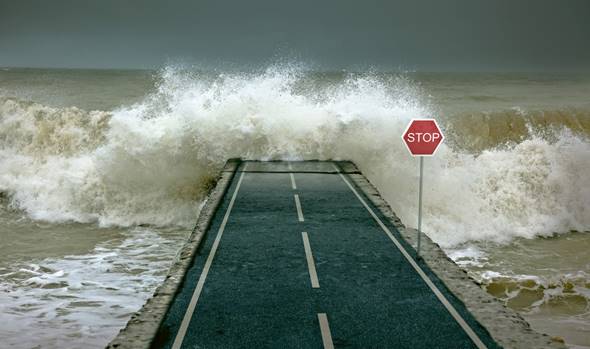
You
have seen how tectonic plates affect Earth's geology. Our planet's surface is
also changed by other forces, including movements within Earth and the weather.
In
this unit, you will learn how landslides, earthquakes, volcanoes, erosion, and
other forces shape and change Earth's geology and help make our planet what it
is today
Surface
Features
Think about your favorite place to visit in
nature. Maybe it is a beach or a park or a mountain.
In your science journal, answer these questions:
1. What is your favorite
place to visit?
2. What are three features
of your favorite place to visit?
3. Did you and your
classmate pick different places? If so, list one feature about your favorite
place that is different than your classmate's. If not, list one feature about
your favorite place similar to your classmate's.
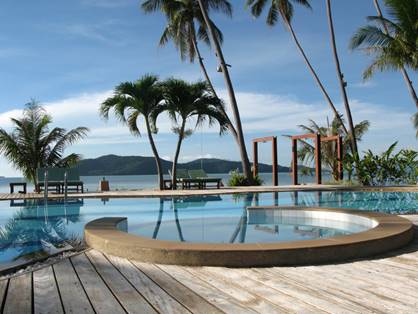
Beach
When you think of Earth, which of these images
is most like what you imagine?

Earth has many places, from snowy mountaintops
to deserts, deep canyons to big oceans. They did not always look like they do
today. It is important to know about Earth's features to tell how they have
changed over time.
Look at the diagram below to explore the main
features of our planet.
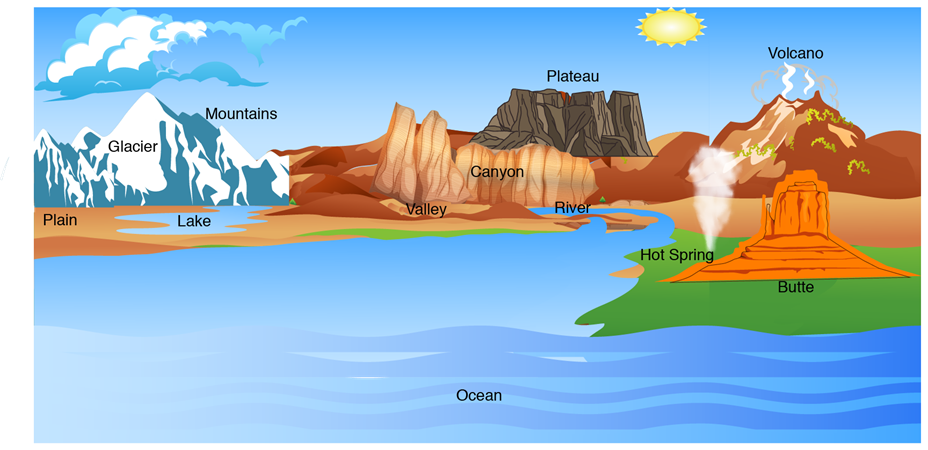
·
Buttes: towers
of rocks with flat tops and steep sides
·
Canyons: low
areas with steep sides around them
·
Glaciers: huge
masses of ice made from snow
·
Hot Springs: a body of water that is hotter than the air
temperature around it
·
Lakes: bodies
of water surrounded by land that often gets water from streams
·
Mountains: rise
above the surrounding land: small mountains are called a hill
·
Oceans:
largest bodies of saltwater
·
Plains: large,
flat areas of land
·
Plateau: large,
flat area with steep sides
·
River: forms
when many streams come together
·
Valleys: a low
area surrounded by mountains
·
Volcanoes: look
like mountains, but they are holes in the Earth
Let’s Practice
Earthquakes
You might have heard of earthquakes—or even
been in one.
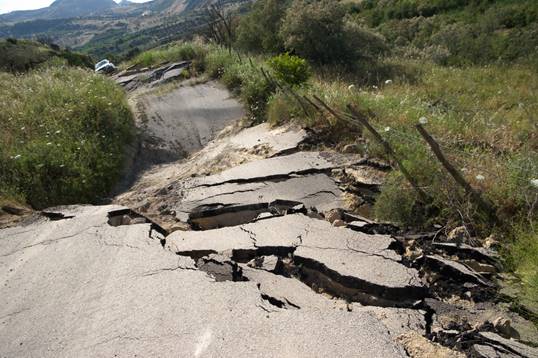
Broken Road
In your science journal, answer this question.
1. Write down five things
you know about earthquakes.
An earthquake is a sudden movement in
the ground that can last a few minutes. Big earthquakes can damage buildings
and kill people and animals.
Almost all earthquakes happen at tectonic plate
boundaries. Convection within the Earth makes the plates move. As they move, the
stress in the rocks builds up. When the stresses are too great,
the rocks break and release a lot of energy, which causes an
earthquake. During an earthquake, rocks usually move several inches (or centimeters).
Watch the video below to understand the makeup
of the Earth's three layers and the mantle's inner workings. You will learn about plate boundaries and the
activity that leads to earthquakes and volcanoes.
Look at the map below. The first one shows fault lines on Earth, and
the second one shows places where earthquakes happen.
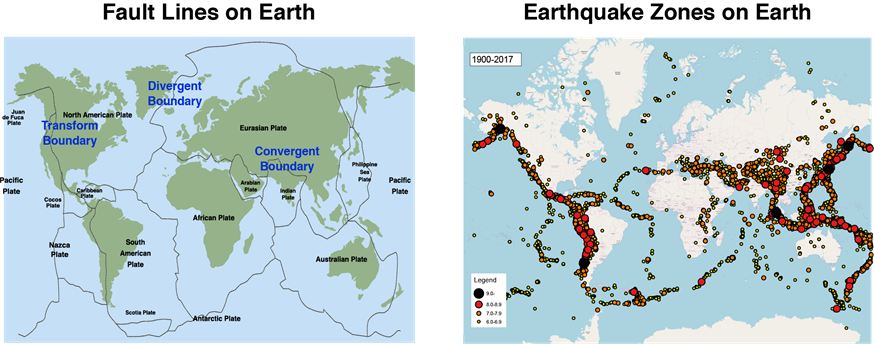
Notice how the earthquakes on the second map
match the fault lines on the first map.
Watch the video below to understand the entire
process of an earthquake. Learn what structures and buildings are more
vulnerable to damage by earthquakes.
Scientists have different ways to predict
earthquakes:
1. Groundwater: Elements of water
change right before an earthquake. Scientists can observe an area's groundwater
to see if an earthquake is about to happen.
2. Fault lines: Scientists track
fault lines to watch for changes because earthquakes happen at fault lines.
3. Foreshocks: Sometimes, the
ground shakes briefly—up to a few weeks—before a bigger earthquake happens,
which gives people a chance to get ready.
4. Ground tilting: The ground can
tilt when rocks underground are stressed, which can
signal that an earthquake is about to happen.
5. Seismograph: The seismograph
is an instrument that measures the shaking of the Earth. Seismic relates to
earthquakes. This tool tells scientists how strongly the Earth is shaking and
helps predict if an earthquake could happen. Strong shaking means the
earthquake could be big and could happen soon. A seismograph works on a simple
idea. The weight at the end of a spring stays still while the base moves. This
movement creates electricity, which makes scribbled lines on paper. When the
Earth is shaking, there are many up-and-down scribbles.
Because earthquakes are so dangerous, scientists
must track them. Scientists monitor earthquakes by measuring their magnitudes.
The magnitude is the energy of the earthquake.
Scientists have different tools for measuring magnitude:
- The moment magnitude scale measures the
total amount of energy of the earthquake
- The Richter magnitude scale measures
the highest amount of energy the earthquake made at one time
Higher magnitudes mean more energy and can lead
to more damage. For example, a 9.0 magnitude earthquake has more energy on
either scale than a 2.0 earthquake. Many earthquakes happen at very small
magnitudes and may not be felt by people. The highest magnitude earthquake ever
recorded was 9.5 in Chile in 1960.
On the Richter scale, a 1.0 earthquake has much
less energy than a 2.0 earthquake. A 2.0 earthquake is ten times as strong as a
1.0 earthquake.
Volcanic
Eruptions
In your science journal, answer this
question.
1.
Write down five things you know about volcanoes.
The video below shows how scientists classify
and detect volcanoes.
Volcanoes shape Earth's features. The changes
can be gradual, or they can happen quickly.
Volcanoes are not always erupting.
The image below shows the three stages of a
volcano.

Stages of a Volcano
Below is an image of volcanic eruptions.
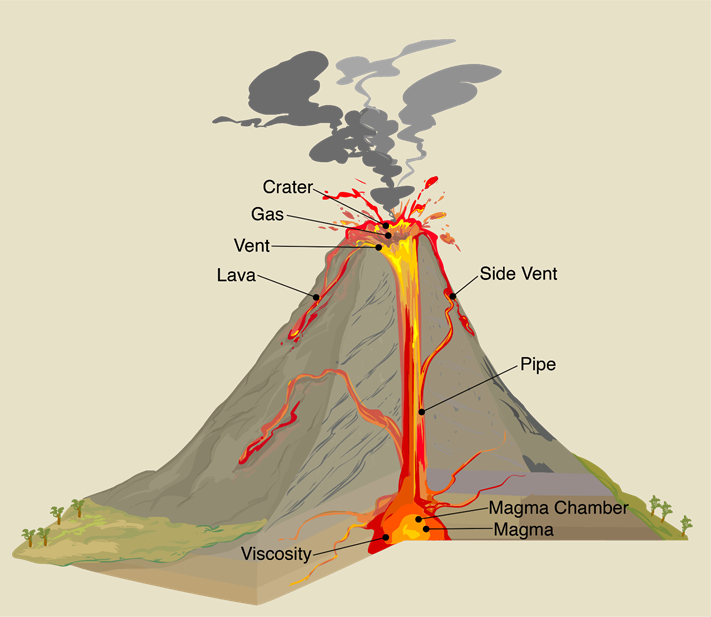
Volcanic Eruptions
·
Viscosity is how thick the magma is inside a volcano. If
the magma is thick, it has a lot of silica, which makes eruptions more
explosive.
·
The lava inside a volcano is called magma. Magma is very hot
and includes gases, minerals, rocks, and hot liquid ions.
·
Magma is stored in a magma chamber inside a volcano.
·
The pipe is a crack
inside a volcano where magma goes from the magma chamber up through a volcano
and then erupts as lava outside.
·
Most magma leaves a volcano in an eruption at the vent and
crater. But sometimes, magma gets through the side cracks of a volcano. These
are called side vents.
·
Once magma goes out of a volcano, it is called lava.
·
Magma goes out of a volcano through the pipe at the vent.
·
A volcano can have a lot or a little water (usually steam) and
carbon dioxide. The more gases it has, the more bubbles rise from
the magma, making eruptions more explosive.
·
The vent is located at a crater around the top of a volcano,
and a lot of lava stays there.
Except for Australia, all the continents have
active volcanoes. A volcano zone is a place on Earth where volcanoes are more
likely to happen, usually at convergent and divergent plate boundaries.
Volcanoes form along these boundaries at hotspots. A hotspot is where the
mantle is very hot and has melted rock. Hawaii is built up on a hotspot, which
is why Hawaii has so many volcanoes.
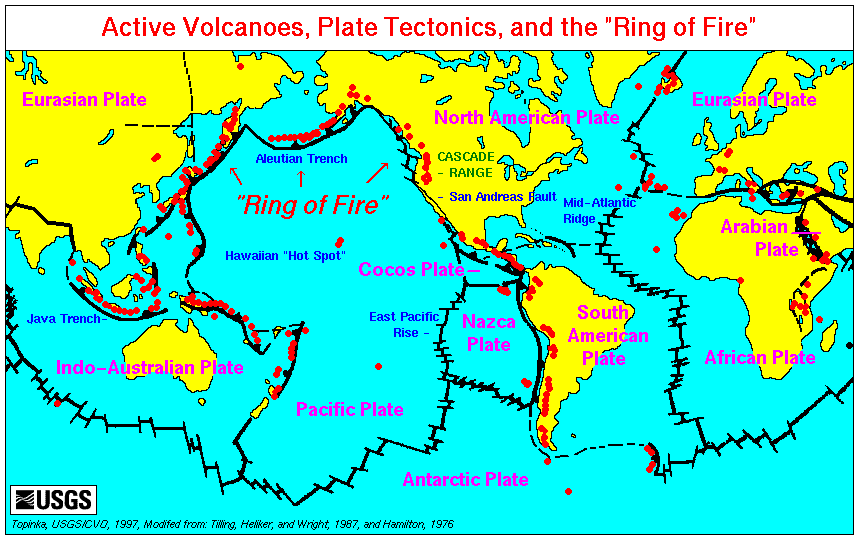
Active Volcanoes
Let’s Practice